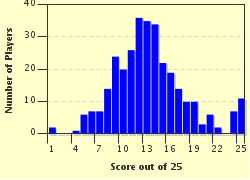Quiz Answer Key and Fun Facts
1. Seen by many as one of the events eventually leading up to the Revolutionary War, the French and Indian War involved someone quite familiar. Which of these men fought in the French and Indian War?
2. There were actually talks of forming a union between the colonies well before the the formation of the Continental Congress. Who proposed the Albany Plan of Union?
3. Britain won many new territories as a result of the Treaty of Paris (1763) ending the French and Indian/Seven Years' War. This included the Ohio River Valley west of the colonies, but which of these events led to Britain preventing colonial expansion further westward?
4. The Sugar Act was passed in order to promote colonial imports of which British product?
5. Which form of currency did the Currency Act of 1764 ban?
6. Which one of these items wasn't taxed by the Stamp Act?
7. Which of these acts repealed the Stamp Act?
8. Who was Charles Townshend (after whom the of the Townshend Acts were named)?
9. Which one of these men was NOT a member of the Sons of Liberty?
10. Which one of these was NOT an activity done by the Daughters of Liberty?
11. Who was the lawyer that defended the British soldiers involved in the "Boston Massacre"?
12. What was the name of the British customs ship that was attacked and burned by the colonists?
13. The Tea Act was passed in order to support what organization?
14. What did the Sons of Liberty disguise themselves as during the Boston Tea Party?
15. Which of these was NOT one of the Intolerable (or Coercive) Acts?
16. Which colony did not attend the First Continental Congress?
17. Who made the political cartoon, "Join, or Die" (with a picture of a snake cut into several segments)?
18. The Suffolk Resolves hampered which attempt to avoid war between the colonies and Great Britain?
19. Who said "Give me liberty, or give me death!"?
20. Which of these men was NOT one of the riders that warned that the British were heading to Concord?
21. One of the earliest battles after the clashes at Lexington and Concord involved the capture of which fort?
22. While the Battle of Bunker Hill is iconic in American history, where did most of the fighting actually take place?
23. Who proposed the Olive Branch Petition?
24. What was the name of the document created by Thomas Paine that encouraged many to support the revolution?
25. The Siege of Boston was one of the most important early battles of the American Revolutionary War and it was won largely due to fortifications put in place by whom?
Source: Author
Avalice
This quiz was reviewed by FunTrivia editor
bloomsby before going online.
Any errors found in FunTrivia content are routinely corrected through our feedback system.


